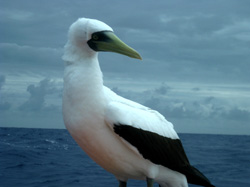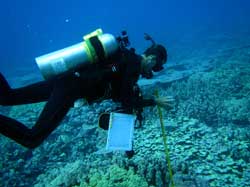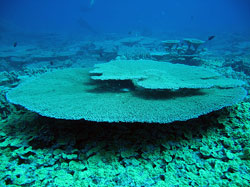
Reef Assessment and Monitoring Program Expediton Log – August 24, 2012
Bittersweet Return!
By: Megan Onuma & Carlie Wiener, COSEE Island Earth

A Masked Boobie sitting on the bow. Its face is unfamiliar to most Hawaiʻi residents, even though they and other seabirds were probably common before human contact. Credit: C. Richer
Reflecting back on the past 24 days, we realize how special the Papahānaumokuākea Marine National Monument is, and what a unique opportunity this expedition has been. The transit back is filled with mixed feelings. After spending so many days immersed in the water, isolated from daily life, and surrounded by nothing but sea birds and open ocean; the realization that we are coming back to the busy hustle and bustle of daily life is sobering. Four days of transit and everyone is starting to get a bit antsy as they put away equipment, pack their bags, and enter data. The transit back to Oʻahu leaves time to ponder about our experiences: swimming amid flourishing corals, watching schools of large fish and sharks, and most importantly helping to understand and monitor these pristine and remote marine spaces. We have had a chance to view the awe-inspiring beauty and complexity of an ecosystem in recovery, a special opportunity that no one will forget.
The respect that we feel for this place must guide our actions when we get home. In fact, it should guide everyone's actions. The importance of teaching people about this protected area is essential, and sharing why it is so critical to maintain this special place. By showing what our reefs can look like, we hope that we can inspire more action in our own backyards, here in the main Hawaiian Islands. The Hawaiian Archipelago needs to be respected as one continuing body; as we cannot properly care for it without having an intimate knowledge of this place. It is important to remember that the Northwestern Hawaiian Islands are intrinsically connected to us. Physically, the waves that wash up onto the shores in the main Hawaiian Islands have touched the beaches all the way at Kure Atoll; historically, the past stories of this place are tightly tied to Hawaiian history; biologically—millions of marine species that transverse through the archipelago find sanctuary in these remote atolls, away from drastic human influence; and spiritually, these islands call out to those willing to listen, who feel the pull of the ocean and the need to care for our special home.

In order to protect the reefs, we must understand them. We need to know what is living there and how it all connects. Credit: M. Onuma
The Papahānaumokuākea Marine National Monument is one of the world's largest marine protected areas covering nearly 140,000 square miles; how do you protect something so large, so vast, so remote? How can we understand any changes that occur to our marine habitats if we do not know what is there to start with? Gathering baseline data through expeditions like RAMP 2012 is how we can monitor these remote areas so that we will be able to see future changes. This is why scientists and managers transit the Northwestern Hawaiian Islands on yearly expeditions, to conduct research and thereby collect information about what is present in our marine ecosystems, and see how our reef habitats are doing.
Of course, there will always be difficulties and ambiguities associated with such research. It is grueling to characterize such a large area, even with science teams carrying out three to four plots daily. It is hard to tell what phenomena are human-related and which are simply natural fluctuations or cycles. This demonstrates the necessity of long-term monitoring. We do our best though, and the RAMP 2012 expedition was a successful gathering of observations and data. With 13 days of diving operations, and 472 dives at 139 sites, our team of 20 educators, scientists, and students worked diligently to record and characterize the coral reef ecosystems.

The coral reefs that have disappeared from the main Hawaiian Islands are allowed to flourish when human influence is removed. Credit: Y. Yasutake
Papahānaumokuākea Marine National Monument is such a large area, and even though hundreds of dives have been completed, we still have only seen a few scattered bits of glass in the grand mosaic. Yet, we return with the hope that from these colored shards, we might glean an idea of the bigger picture of what is going on up there in our Northwestern neighborhood, and how best to take care of it. Let this be a reminder that we can carry out these monitoring techniques here in our own backyard, but most importantly we need to learn to malama our oceans, so that we do not have to witness human impacts to our reefs. The specialness of Papahānaumokuākea is felt by every scientist onboard, once you have spent time in this place it never leaves you. We hope that places like the Northwestern Hawaiian Islands will continue to remain, wild, undamaged, and majestic, for generations to come.
Click here to go back to the Expedition Log.
